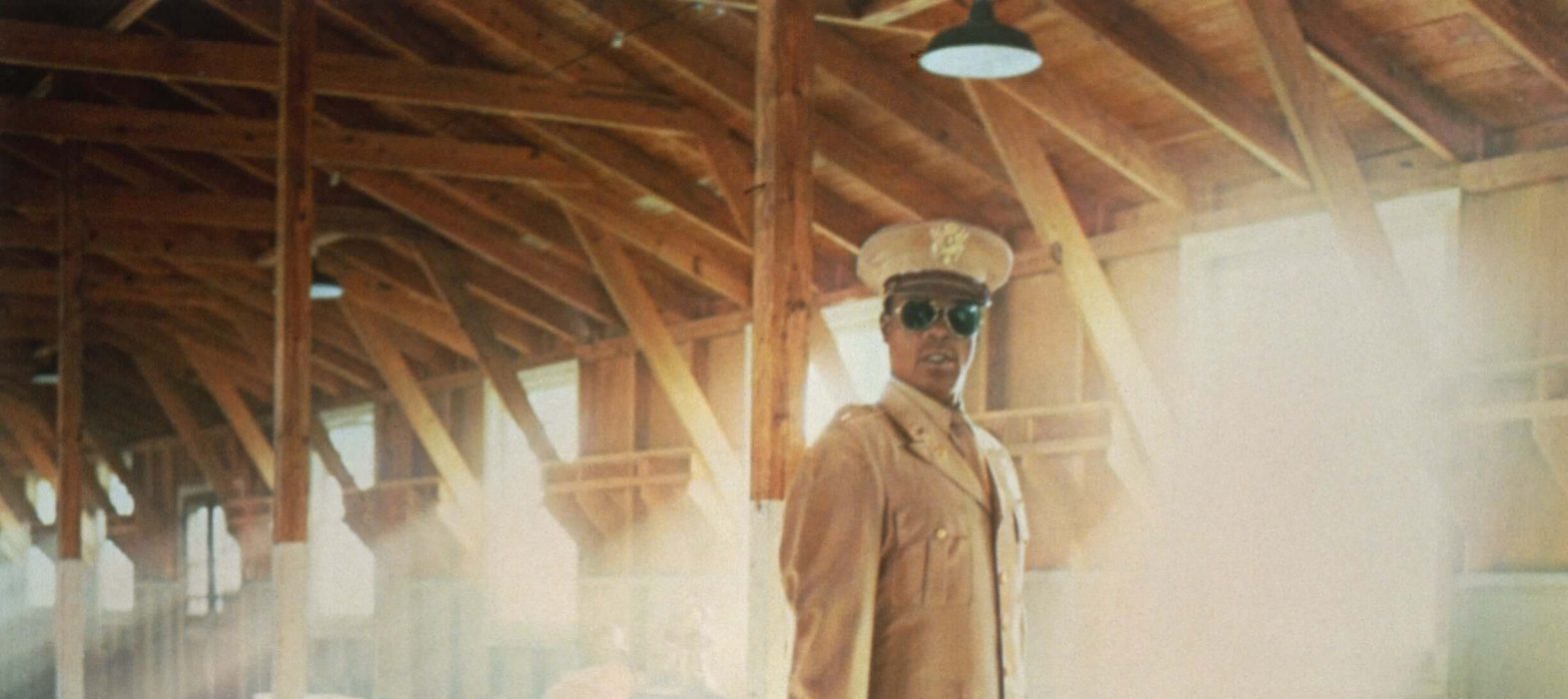Starring: Howard Rollins, Adolph Caesar, Dennis Lipscomb and Denzel Washington
Rated: PG Crime/Drama/Mystery
Set on a racially-segregated military base in rural Louisiana during World War II, A Soldier’s Story is a film adapted from Charles Fuller’s Pulitzer Prize-winning production, “A Soldier’s Play”. Directed by Norman Jewison, the film centers around the investigation by U.S. Army Captain Richard Davenport (Howard Rollins), an African-American officer from the Judge Advocate General’s Corps, into the murder of Master Sergeant Vernon Waters (Adolph Caesar), who is also African-American. Taking place in 1944, in the Jim Crow-dominated South, racism drastically impacts Davenport’s investigation. Both White and Black officers feel they don’t have to respect Davenport and his rank, simply because of his race.
The film opens with the murder of a drunken Sergeant Waters, also called “Sarge” by his colored soldiers. His body is found and the following day, Davenport is dispatched to the military base. Because Sarge is found with his military regalia intact on his uniform, some don’t believe that the killing was committed by members of the local branch of the Ku Klux Klan, who would have removed it. Is all really as it seems to appear?
From the beginning, Davenport experiences hindrances to his investigation and these are from White officers, including commanding officer Colonel Nivens (Trey Wilson), who only gives Davenport three days to solve the murder of “Sarge”; Captain Taylor (Dennis Lipscomb), who often is clueless and patronizing; and Captain Wilcox (Scott Paulin) and Lieutenant Byrd (Wings Hauser), who are menacing. Davenport also receives hostile treatment from several Black soldiers who resent his presence, military status, accomplishments and questioning. These soldiers include Private Peterson, (Denzel Washington), who stood up to the tyranny that Waters imposed on Black soldiers only and (Art Evans), who Waters demoted from sergeant to private for being drunk on duty.
From his questioning, Davenport learns that when the Black soldiers weren’t training for the possibility to be sent overseas to serve, many of them, who were Negro League baseball players, would train as a unit to play baseball. When Whites were not around, Waters, assigned to manage the unit, was often cruel to the Black players, especially those from the South. After learning more about Waters, he discovers two more deaths occurred on the base and that Waters was connected with both. Facing threats and a ticking timeclock, will Captain Davenport be able to attain justice in only 72 hours?
Despite the reluctancy and refusal of major motion picture studios, such as Metro-Goldwyn Mayer (MGM) and Warner Brothers, to produce a film that dealt with racial discrimination in the American South on a U.S. Army base during World War II, A Soldier’s Story was received with critical acclaim. Columbia Pictures felt the story was culturally significant but questioned the potential commercial value. Because Norman Jewison believed in its possible success, he and many of the cast members worked for scale or less on a budget of only five million dollars. Jewison, having offered to direct it with no salary, ended up taking the lowest possible salary as per the guidelines of the Directors Guild of America. The film was a box office success, earning over twenty-two million dollars.
A Soldier’s Story was also a critical hit, nominated for several accolades such as the Academy Award for “Best Picture” and Golden Globe Award for “Best Motion Picture”. Norman Jewison was nominated to be awarded for “Outstanding Directorial Achievement in Motion Pictures” by the Directors Guild of America. Adolph Caesar was nominated for an Academy Award for “Best Supporting Actor” and for a Golden Globe Award for “Best Actor in a Supporting Role in a Motion Picture.”
The film won awards, including the NAACP Image Award for “Outstanding Motion Picture” and the “Golden Prize” at the 14th Moscow International Film Festival. African-Americah playwright Charles Fuller, nominated for an Academy Award, a Golden Globe Award and the Writers Guild of America award, won the Edgar Award for “Best Motion Picture Screenplay”.
Howard E. Rollins, Jr., having previously been nominated for an Academy Award for his role as “Coalhouse Walker, Jr.” in Ragtime, was cast as Captain Richard Davenport in the film. Many of the other cast members had previous experience acting in the theatre. These theatre trained actors included Adolph Caesar, Denzel Washington, and William Allen Young, who were the only actors to star in in both “A Soldier’s Play”, the original off-Broadway production of the Negro Ensemble Company, and the film. This film would be a springboard, introducing quite a number of Black actors, including David Alan Grier, Larry Riley, Robert Townsend and William Allen Young, to new audiences.
Although the plot is set in Louisiana, A Soldier’s Story was filmed solely in Arkansas, including Fort Chaffee and Fort Smith and the cities of Clarendon and Little Rock. As the governor of Arkansas at the time of the filming, Bill Clinton strongly supported the film project and, because of the severely tight budget of Columbia Pictures, provided the Arkansas Army National Guard in full regalia for the ending scene.





